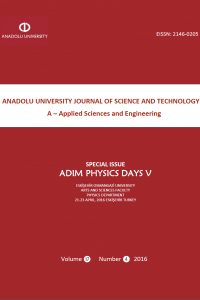Abstract
References
- [1] Chintakula G, Rajaputra S, Singh V P. Schottky diodes on nanowires of copper phthalocyanine. Solar Energy Materials & Solar Cells 2010; 94: 34–39.
- [2] Shah M, Sayyad M H, Karimov Kh S, Maroof-Tahir M, Investigation of the electrical properties of a surface-type Al/NiPc/Ag Schottky diode using I–V and C–V characteristics. Physica B 2010; 405: 1188–1192.
- [3] Mukherjee B, Mukherjee M. Programmable memory in organic field-effect transistor based on lead phthalocyanine. Organic Electronics 2009; 10: 1282–1287.
- [4] Yazıcı A, Dalbul N, Altındal A, Salih B, Bekaroğlu Ö, Partition coefficient-Lewis basicity correlation in four dioxycyclo butenedion-bridged novel ball-type phthalocyanines, Synthetic Metals. 2016; 212: 25–30.
- [5] Şahin S, Altun S, Altındal A, Odabaş Z. Synthesis of novel azo-bridged phthalocyanines and their toluene vapour sensing properties, Sensors and Actuators B. 2015; 206: 601–608.
- [6] Bechara R, Petersen J, Gernigon V, Lévˆeque P, Heiser T, Toniazzo V, Ruch D, Michel M. PEDOT:PSS-free organic solar cells using tetrasulfonic copper phthalocyanine as buffer layer. Solar Energy Materials & Solar Cells. 2012;98: 482–485.
- [7] Sharma G D, Balarajua P, Sharma P S K, Roy M S. Charge conduction process and photoelectrical properties of Schottky barrier device based on sulphonated nickel phthalocyanine. Synthetic Metals. 2008:158;15;620-629.2008:158;
- [8] Pakhomov G L, Leonov E S, Klimov A Y, Microelectron. J. 2007; 38: 682.
- [9] Soliman H S, Farag A A M, Khosifan N M, El- Nahass M M. Electrical transport mechanisms and photovoltaic characterization of cobalt phthalocyanine on silicon heterojunctions. Thin Solid Films. 2008; 516: 8678.
- [10] Yazıcı A, Dalbul N, Altındal A, Salih B, Bekaroğlu Ö. Ethanol sensing property of novel phthalocyanines substituted with3,4-dihydroxy-3-cyclobuten-1,2-dione. Sensors and Actuators B. 2014; 202: 14–22.
Abstract
The temperature dependent
current–voltage characteristics of Ag/ZnPc/p-Si Schottky barrier (SB) diode are
investigated in the temperature range of 300–450 K, and in the bias range of ± 1 V. By fitting the
experimental data to space-charge limited conduction, bulk-limited Poole–Frenkel emission and
thermo-ionic emission theory, it was observed that these models can not be applied to evaluate
junction parameters for the investigated SB diode. Preliminary results
indicated that the charge transport proceeds
by different mechanism for low and high values of the applied voltage under forward and reverse bias conditions. It
was found that the charge transport is governed by hopping processes for low
values of the forward bias. However, for higher values of the forward bias, the
charge transport controlled by the bulk limited procesess. The same voltage
dependence was also observed for reverse bias conditions.
Keywords
References
- [1] Chintakula G, Rajaputra S, Singh V P. Schottky diodes on nanowires of copper phthalocyanine. Solar Energy Materials & Solar Cells 2010; 94: 34–39.
- [2] Shah M, Sayyad M H, Karimov Kh S, Maroof-Tahir M, Investigation of the electrical properties of a surface-type Al/NiPc/Ag Schottky diode using I–V and C–V characteristics. Physica B 2010; 405: 1188–1192.
- [3] Mukherjee B, Mukherjee M. Programmable memory in organic field-effect transistor based on lead phthalocyanine. Organic Electronics 2009; 10: 1282–1287.
- [4] Yazıcı A, Dalbul N, Altındal A, Salih B, Bekaroğlu Ö, Partition coefficient-Lewis basicity correlation in four dioxycyclo butenedion-bridged novel ball-type phthalocyanines, Synthetic Metals. 2016; 212: 25–30.
- [5] Şahin S, Altun S, Altındal A, Odabaş Z. Synthesis of novel azo-bridged phthalocyanines and their toluene vapour sensing properties, Sensors and Actuators B. 2015; 206: 601–608.
- [6] Bechara R, Petersen J, Gernigon V, Lévˆeque P, Heiser T, Toniazzo V, Ruch D, Michel M. PEDOT:PSS-free organic solar cells using tetrasulfonic copper phthalocyanine as buffer layer. Solar Energy Materials & Solar Cells. 2012;98: 482–485.
- [7] Sharma G D, Balarajua P, Sharma P S K, Roy M S. Charge conduction process and photoelectrical properties of Schottky barrier device based on sulphonated nickel phthalocyanine. Synthetic Metals. 2008:158;15;620-629.2008:158;
- [8] Pakhomov G L, Leonov E S, Klimov A Y, Microelectron. J. 2007; 38: 682.
- [9] Soliman H S, Farag A A M, Khosifan N M, El- Nahass M M. Electrical transport mechanisms and photovoltaic characterization of cobalt phthalocyanine on silicon heterojunctions. Thin Solid Films. 2008; 516: 8678.
- [10] Yazıcı A, Dalbul N, Altındal A, Salih B, Bekaroğlu Ö. Ethanol sensing property of novel phthalocyanines substituted with3,4-dihydroxy-3-cyclobuten-1,2-dione. Sensors and Actuators B. 2014; 202: 14–22.
Details
| Subjects | Engineering |
|---|---|
| Journal Section | Articles |
| Authors | |
| Publication Date | December 1, 2016 |
| Published in Issue | Year 2016 Volume: 17 Issue: 4 |

